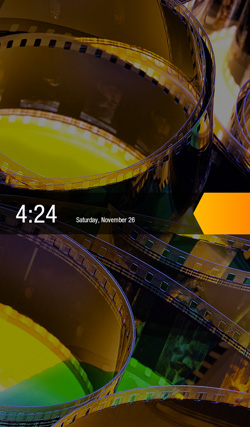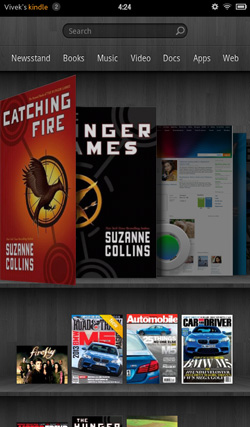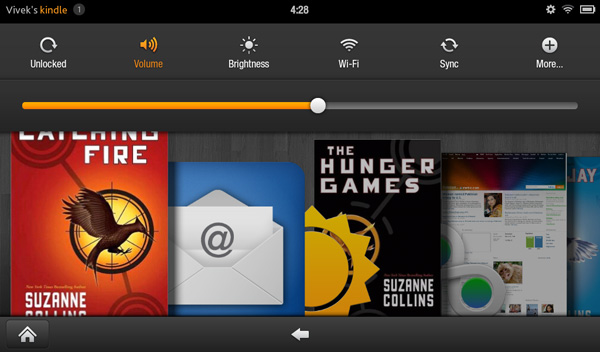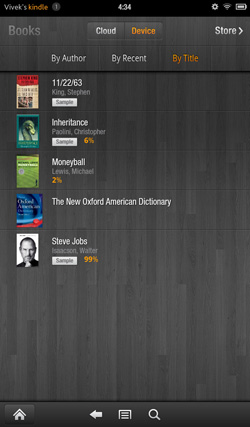Amazon Kindle Fire Review
by Anand Lal Shimpi & Vivek Gowri on November 29, 2011 3:31 AM EST- Posted in
- Tablets
- Mobile
- Amazon
- Kindle Fire
- Kindle
The Operating System
There are three reasons why the Kindle Fire is one of the most important tablet releases of the year: software, services, and shopping. The hardware, while nice, plays a definite secondary role here. The user experience, with tight-knit integration with Amazon's full suite of digital media services (Kindle, Appstore for Android, MP3 Cloud Player, and Prime Instant Video), is what makes the Kindle Fire the most formidable threat.
Amazon and Lab 126 have taken the same route as Barnes and Noble here and built the Kindle Fire operating system on top of Android 2.3. This is basically a skinned version of Gingerbread just as you'd find on an HTC Flyer or the old Galaxy Tab 7", but instead of augmenting the stock Android experience, the goal here is to hide it entirely. When you press the (stupidly located) lock button, you're treated to a simple lock screen, featuring a high resolution image of Amazon's choosing and an orange lock slider with the day, date, and time. Note that you cannot change the lockscreen image without rooting the device.
Slide the bar over to get to the homescreen, and you find yourself looking at a virtual bookshelf of apps. The top shelf is called the Carousel. It's a rotating, Cover Flow-style list of recently used files and applications that you can swipe through. It's nice, in that you can switch between your recent windows, but there's too many app windows that are stored. This leads to two problems: there can be some choppiness in the animation if you try to scroll through the entire list quickly, and overall it's a bit visually chaotic and disorganized. It's good, but it'd be better if they shortened the list to just the last 8-10 items. The shelves underneath are made up of items you deem "favorites". You can pin almost any content to the mainscreen - applications, magazines, newspapers, books, albums, playlists, videos, documents, websites; just hold down the icon/cover to add to favorites, then it'll show up on your homescreen. 4 icons per shelf, and the size of your bookshelf grows downwards as you add more content to it. However, as you add more content, scrolling through the bookshelf tends to get a bit choppy.
The notification bar from Android 2.x is still there, but the notification drawer is a push-button affair instead of a slide-down windowshade. The left side of the notification bar contains the battery and WiFi indicators as well as a small gear. Press it to bring down the quick setting options, and select "More..." to get to the full settings menu. The quick settings options are the rotation lock, volume and brightness controls, wireless settings, and a manual sync button. The main menu settings are relatively limited compared to normal Android, mostly account and security options, along with the standard device settings: sounds, display timeout, keyboard, network, date/time, and application permissions. The notification tone catalogue is basically lifted from Honeycomb, as are the keyboard touch sounds. The sounds are basically the only personalization options you've got. There's no real wallpaper to speak of other than the dark gray bookshelf, and as mentioned before, you can't touch the lockscreen images.
There are no hardware buttons, so the standard Android navigation buttons show up on a bottom navigation bar. The Home button and back button are always present, joined by the menu button and search when relevant. The menu bar disappears when you're viewing print or video content, necessitating a touch of the screen to bring up the navigation bar.
Above the Carousel is a list of the different content areas. You can access the web or one of the content libraries by hitting the corresponding name: Newsstand, Books, Music, Video, Docs, Apps, Web. Web takes you to the browser, Apps takes you to the main application launcher, and the rest of the content areas are mostly self-explanatory. It's the only way to access the browser, the launcher, and the music player, so you'll use those buttons often. Above the content libraries is a search box that searches through your books, magazines, documents, movies, music, and apps. We'll cover all of these systematically, starting with the browser, which Amazon says is "cloud-accelerated" using the computing back-end of Amazon Web Services. It's called Silk.















70 Comments
View All Comments
geniekid - Tuesday, November 29, 2011 - link
Just to add to what I said. At the start of the review you say "The Kindle Fire and iPad 2 couldn't be more different. They are vastly different sizes, shapes and prices. They even serve slightly different functions."I strongly disagree with that statement. If you asked me what a Fire was out of the blue, I'd say it was a tablet that let you read ebooks, watch movies, browse the internet, and run some third party apps. I'd say the exact same thing if you asked me what an iPad was. Without reading a review comparing the two, I would never know why the iPad is better at all those things. And I would never know why I might still buy a Fire knowing that the iPad is superior at all those things.
DukeN - Tuesday, November 29, 2011 - link
I feel like I'm RIM's personal crusader here on AT, as you seem to neglect their products quite a bit.Is this really a better device than the $199 Playbook? I suppose for Amazon content oriented folks it might be. Using that specific use niche as a decision maker, the Playbook would be better for those looking to pair it with their Blackberry device (no data plan required, or even Wifi).
The playbook at the same price right now gives you twice the storage, dual 5MP and 3MP cameras, 1080p video recording and silky smooth browser/multi-tasking performance.
Is the Fire really the best $199 tablet at the moment? I think until they spec up their hardware this isn't the case.
VivekGowri - Wednesday, November 30, 2011 - link
Can we have this conversation after the PlayBook gets a native email client?DukeN - Wednesday, November 30, 2011 - link
Um, it has one called the web browser. Just the way MAJORITY of people access their email with a PC/notebook at home. And it has one that works with users with Blackberry devices. Secondly, knowing that it is coming in February, doesn't it make more sense to buy the better hardware that will add one piece of software functionality? Also, I'll tell you what's blatantly unacceptable, A TABLET WITHOUT A CAMERA.Reflex - Wednesday, November 30, 2011 - link
Um, you can have web based email on a 7" screen. I'll take a native app, thanks. Web layouts suck on small screens. Furthermore, web based clients suck if I'm not online at the time, I can compose and send messages in an airplane on my Fire just fine and they will get delivered the next time I connect to a WiFi AP7, on a Playbook I'm stuck.Not saying the Playback is a bad device. Only that its incomplete in ways that the Fire and Nook are complete. If you have a BB, a Playbook is pretty much a given, but for the rest of us, thats not the case.
DukeN - Thursday, December 1, 2011 - link
If email is that critical to you, as a deciding factor, you probably already have the best thing for email. It's called a BLACKBERRY. And chances are, the only tablet you would then want to buy is a Playbook.The Fire is like buying a Core 2 Duo because it supports Outlook, while the Playbook is like an i7 that only supports Outlook Web Access until February.
Missing cameras, and half the storage (8GBs will go FAST) is a bigger shortcoming IMO.
Also, by your own words, if you have a BB the playbook is a given. So for millions of people in North America, it is the best tablet, according to you. So how is the Kindle a better buy, at $199?
Reflex - Thursday, December 1, 2011 - link
It depends on your needs. Nobody is saying that the Playbook is useless. But most people do not own a BB, or if they do they plan to migrate off of it soon(its losing customers quarter over quarter consistently now). And without a BB, the Playbook as it stands is a pretty limiting device.For someone with a BB, the Playbook is a strong consideration, especially if they intend to keep their BB. But for those of us who do not have a BB, the other 80% of the phone market(I use WP7), a Playbook makes little sense given its limitations. I don't care about a camera on a tablet, my phone does that fine. I do agree that 8GB is limiting, but it is a limit I am willing to live with. If storage was my primary concern I'd have a Nook Tablet since I can use SDHC on it. Also, Amazon has a much more complete app store, plus I can sideload apps from the Google Marketplace as well.
I'm not saying the Playbook is a big deal. But for those of us without a BB, its a pretty incomplete experience comaparatively.
doesitreallymatter - Friday, December 2, 2011 - link
For a hardware review site I find the conclusion that this is the tablet to get at $199 (as opposed to the playbook) very suspect.The biggest problems people seem to have with the playbook is the lack of a native email client, which RIM has stated is coming in Feb. This update in February is supposed to bring android support to the playbook as well, however limited it may be. As this review notes though, the app support appears to be limited for the fire as well.
So again, why is this tablet preferred over the playbook which has double the memory, front and back cameras and at least twice the storage?
There is a bias against RIM present in the media and that cannot be denied.
Not sure why I'm even bothering to post here. People have become more fanatic about their phones than people were back in the days of X gaming console is better than Y gaming console.
DukeN - Friday, December 2, 2011 - link
Thank you for saying it out loud.Still waiting for AT's review of a single BB 7 OS device.
I think I've seen major coverage of every single Android, and iOS updates here on AT. Even Windows phone reviews!
But not a single BB review. Granted, only 10-20% of smartphone users are RIM users, but that's still MILLIONS of people. And a lot more than what some of these android/WP7 devices will ever get.
doobydoo - Thursday, December 8, 2011 - link
You guys can't, or shouldn't just gloss over such a massive failure like not having a proper integrated email client.That's VERY important for a lot of people, and who wants to buy a tablet which they have to wait 3 months until they can use it properly (assuming the update even comes).
RIM have a bad reputation at the moment for several very good reasons and that's a legitimate factor too - they have all but failed already. People with BB's are moving away, and fast.
The amazon eco system is far superior and the Playbook is just an incomplete and uncompetitive mess.